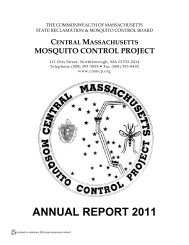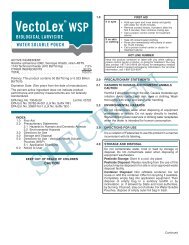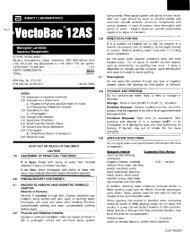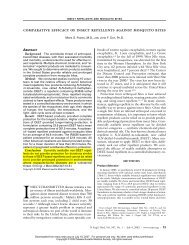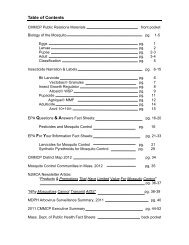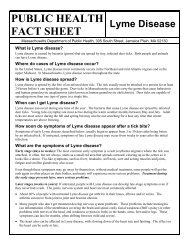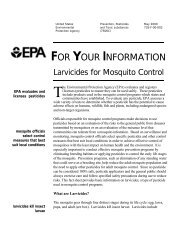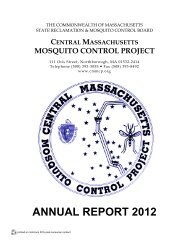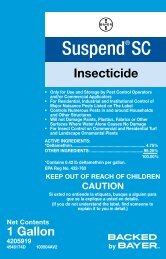marlboro - Central Mass. Mosquito Control
marlboro - Central Mass. Mosquito Control
marlboro - Central Mass. Mosquito Control
Create successful ePaper yourself
Turn your PDF publications into a flip-book with our unique Google optimized e-Paper software.
RESISTANCE TO SCOURGE® INSECTICIDE IN THE MOSQUITO POPULATIONS<br />
OF FOUR TOWNS IN THE CENTRAL MASS. MOSQUITO CONTROL PROJECT<br />
SERVICE AREA: WESTBOROUGH, BILLERICA, TEWKSBURY, AND WILMINGTON<br />
ANN G. PARSLEY, Research Technician & TIMOTHY D. DESCHAMPS, Executive Director<br />
<strong>Central</strong> <strong>Mass</strong>. <strong>Mosquito</strong> <strong>Control</strong> Project<br />
111 Otis Street Northborough, <strong>Mass</strong>achusetts 01532<br />
ABSTRACT<br />
The <strong>Central</strong> <strong>Mass</strong>achusetts <strong>Mosquito</strong> <strong>Control</strong> Project (CMMCP) has been using a synthetic<br />
pyrethroid called resmethrin, trade name Scourge®, since the early 1990’s to control adult<br />
mosquito populations in its service area. The current CMMCP policy is to accept service<br />
requests from residents and town officials for adult mosquito control and to perform limited,<br />
targeted applications, and not perform random, area-wide spraying as was the standard<br />
procedure for adult mosquito control in <strong>Mass</strong>achusetts decades ago. As part of our Standard<br />
Operating Procedures manual and as a function of an Integrated <strong>Mosquito</strong> Management (IMM)<br />
plan, surveillance is analyzed before any product is applied to justify the application. This can be<br />
in the form of landing rate counts or data collected from mosquito traps. Resistance to a class of<br />
chemicals has been noted in other areas of the world, and we will attempt to determine if any<br />
mosquito species or any collections of mosquitoes from a given area will show resistance to the<br />
synthetic pyrethroid class of chemicals. If resistance is noted, this may affect the product choice<br />
for vector-borne disease control, as well as the reduction of nuisance levels of mosquitoes. Initial<br />
results from 2005 show a minor potential for resistance, but no change in product usage is<br />
recommended at this time. There is no indication that resistance levels will increase due to the<br />
limited, sporadic nature of the CMMCP adulticide program, but further study would be prudent.<br />
INTRODUCTION<br />
The purpose of this study was to determine whether or not resistance to resmethrin was developing in the<br />
mosquito populations at the most frequently sprayed properties. If significant resistance were present, it<br />
could necessitate changing from resmethrin to a different product registered in <strong>Mass</strong>achusetts and<br />
accepted by the Centers for Disease <strong>Control</strong> (CDC) for mosquito control. This would be particularly<br />
important in the case of an outbreak of mosquito-borne diseases such as West Nile Virus (WNV) or<br />
Eastern Equine Encephalitis (EEE). If a particular species of mosquito or a mosquito collection from a<br />
given area has been shown to be resistant to the pyrethroid class of chemicals, then vector suppression<br />
may need to be done using different products and procedures. The towns of Westborough, Billerica,<br />
Tewksbury and Wilmington were chosen for the study because these are the only towns in the CMMCP<br />
service area where WNV or EEE have been found either in mosquitoes, horses or humans. WNV was<br />
found in a collection of mosquitoes in Westborough in 2003, and that same year a woman in the area of<br />
the virus positive mosquito also contracted WNV. Horses in Billerica and Wilmington were identified to<br />
have been infected with EEE in 2004, and mosquitoes positive for EEE were found in Tewksbury in 2002.<br />
METHODS AND MATERIALS<br />
Five study sites were chosen in each town, from among the most frequently sprayed properties in the<br />
town according to the CMMCP database of service requests. The frequency of spraying was determined<br />
from a database of spray requests from 1998 to the present. Because the towns vary in their overall<br />
mosquito population and the number of requests is determined by the property owners, no two sites had<br />
exactly the same number of requests in each season. The number of spray requests varied considerably.<br />
The most frequently sprayed property had been sprayed 38 times over the eight year period, while the<br />
least frequently sprayed property had only been sprayed four times, all in 2004. Most of the properties<br />
had been sprayed between 12 and 25 times since 1998. All but two of the properties were at private<br />
homes; one was a public recreational area, and another was a wetland area at the end of a cul-de-sac.





